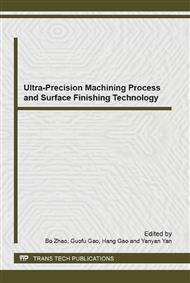[1]
D. Kim, S. Oh, Atomistic simulation of structural phase transformations in monocrystalline silicon induced by nanoindentation, J. Nanotechnology. 17(2006) 2259-2265.
DOI: 10.1088/0957-4484/17/9/031
Google Scholar
[2]
Z. J. Yuan, X. K. Wang, Precision and ultra-precision processing technology, second ed., China Machine Press, Beijing, (2010).
Google Scholar
[3]
S. Van, Stacking fault energies and slip in nanocrystalline metals, J. Nature Materials. 3(2004)399-403.
DOI: 10.1038/nmat1136
Google Scholar
[4]
K. Mylvaganam, L. C. Zhang, Nanotwinning in monocrystalline silicon upon nanoscratching, J. Scripta Mater. 65(2011) 214-216.
DOI: 10.1016/j.scriptamat.2011.04.012
Google Scholar
[5]
K. Tada, S. Horimoto, Y. Kimoto, Molecular dynamics study on compressive strength of monocrystalline, nanocrystalline and amorphous Si mold for nanoimprint lithography, J. Microelectronic Engineering. 87(2010) 1816-1820.
DOI: 10.1016/j.mee.2009.10.026
Google Scholar
[6]
X.G. Guo, D.M. Guo, R.K. Kang, Z.J. Jin. Molecular Dynamics Analyze on Effects of Abrasive Size and Cut Depth on the Monocrystal Silicon Grinding, J. Key Engineering Materials. 25(2006) 304-305.
DOI: 10.4028/www.scientific.net/kem.304-305.286
Google Scholar
[7]
S. Jing, V. Mayank, Comparing Atomistic Machining of Monocrystalline and Polycrystalline Copper Structures, J. Materials and Manufacturing Processes. 26(2011) 1004-1010.
DOI: 10.1080/10426914.2010.515641
Google Scholar
[8]
K. Mylvaganam, L.C. Zhang, Nanotwinning in monocrystalline silicon upon nanoscratching, J. Scripta Materialia. 65(2011) 214-216.
DOI: 10.1016/j.scriptamat.2011.04.012
Google Scholar
[9]
C. Kittel, Introduction to Solid State Physics, Chemical Industry Press, Beijing, (2011).
Google Scholar
[10]
J. Tersoff, Modeling Solid-state Chemistry: Interatomic Potentials for Multicomponent System, J. Physics Review B. 41(1989) 5566-5568.
DOI: 10.1103/physrevb.39.5566
Google Scholar
[11]
Y. Lin, S. Jian, Y. La, Molecular Dynamics Simulation of Nanoindentation-induced Mechanical Deformation and Phase Transformation in Monocrystalline Silicon, J. Nanoscale Res Lett. 3(2008) 71-75.
DOI: 10.1007/s11671-008-9119-3
Google Scholar
[12]
Y. Lin, T. Chen, P. Yang, Atomic-level simulations of nanoindentation-induced phase transformation in mono-crystalline silicon, J. Applied Surface Science. 254(2007) 1415-1422.
DOI: 10.1016/j.apsusc.2007.06.071
Google Scholar
[13]
H. Tanata, S. Shimada, L. Anthony, Requirements for Ductile-mold Machining Based on Deformation Analysis of Mono-crystalline Silicon by Molecular Dynamic Simulation, J. Annals of the CIRP. 56(2007) 53-56.
DOI: 10.1016/j.cirp.2007.05.015
Google Scholar


